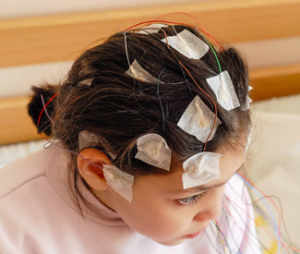“Neurofibromatoses” is the collective term for a group of genetic disorders that can cause tumor growth across multiple locations in the nervous system and its tissues.
Depending on the particular type of neurofibromatosis, it affects various components of the nervous system including the:
- Nerves
- Spinal cord
- Brain
The condition can be inherited from the parents because, again, there is a demonstrated genetic component to the disease; however, between 30-50% of affected individuals have no documented family history of the disorder. In these cases, the genetic mutations that cause neurofibromatosis occur spontaneously during conception.
In many cases, the tumors caused by neurofibromatosis are not cancerous (benign), but some can be malignant, so patients should always have them examined by an experienced oncologist/neurologist.
Potential complications of the condition include learning difficulties, cardiovascular issues affecting the blood vessels and heart, chronic pain, vision loss and hearing loss. With proper treatment, the risk of developing serious complications related to neurofibromatosis can be mitigated or avoided altogether.
Let’s explore the different varieties of neurofibromatosis and their similarities and distinctions.
Three Types of Neurofibromatosis and Their Symptoms
There are 3 types of neurofibromatosis, which have distinct diagnostic criteria, symptoms, and treatments. These are:
- Neurofibromatosis Type 1 (NF-1)
- Neurofibromatosis Type 2 (NF-2)
- Schwannomatosis
Here, we’ll explore the important differences across these different forms of neurofibromatosis that patients and their caregivers should understand.
Neurofibromatosis Type 1 (NF-1)
Type one develops in childhood. Often, the signs and symptoms of NF-1 are observable starting at birth, but inevitably become evident by age 10. The severity of NF-1 varies on a case-by-case basis, but the symptoms are usually mild to moderate.
NF-1 symptoms include:
- Light brown skin spots (called “café au lait spots”). These are harmless generally and tend to present themselves during early childhood. More than six café au lait spots typically indicate NF-1.
- Small stature. Children with NF-1 are often shorter than their peers.
- Learning disabilities. In addition to struggling with specific academic disciplines like math or reading, attention-deficit/hyperactivity disorder (ADHD) and speech delay are also common accompanying conditions that impact the learning abilities of affected patients.
- Optic nerve tumors (optic glioma). 75% of all optic glioma diagnoses occur in patients under 10 years old and account for roughly 5% of all brain tumors in children.
- Abnormal bone development of the spine, a skull bone, or the tibia associated with bone mineral deficiency.
- Abnormally large head size. Greater brain volume frequently results in large head size in affected children.
- Two or more growths on the iris of the eye (Lisch nodules), subtle nodules that don’t negatively affect vision.
Neurofibromatosis Type 2 (NF-2)
Neurofibromatosis Type 2 (NF-2) occurs less commonly than NF-1. (
The main differences between NF-2 and NF-1 are that NF-2 usually presents later in life (rare for children) and that its symptoms are generally less obvious than NF-1, making the diagnostic process slightly more challenging.
In addition to the tumors, a person with NF-2 may have cataracts at an early stage, changes in the retina, and other nervous system tumors.
The symptoms of NF-2 might include:
- balance problems
- glaucoma (eye condition causing damage to the optic nerve)
- hearing loss
- vision impairment
- ringing in the ears (tinnitus)
- seizures
- numbness or weakness in arms and legs
Schwannomatosis
Schwannomatosis is the third, and rarest, type of neurofibromatosis and usually affects adult patients.
This is characterized by the development of multiple schwannomas (a certain type of nervous system tumor that grow from cells called Schwann cells).
In most cases, the tumors caused by Schwannomatosis are benign, but they can be cancerous in certain cases.
These tumors can occur throughout the body. The predominant symptom of these tumors are:
- Chronic pain that might manifest anywhere throughout the body
- Numbness or weakness that might occur in multiple body parts
- Muscle loss
How Do Neurologists Diagnose Neurofibromatosis?
Neurologists rely on a combination of physical and imaging tests to make a neurofibromatosis diagnosis. This battery of tests can include:
- Vision tests
- Audiometry
- CT scan (to check for bone abnormalities, brain or spinal cord tumors, and very small tumors not detectable through other means)
- Genetic testing.
- MRI scan
- balance tests
- Blood tests can diagnose all three forms of neurofibromatosis.
- Physical examination to look for “café-au-lait” spots (the most common feature of NF-1)
How Do Neurologists Treat Neurofibromatosis?
There is currently no known cure for neurofibromatosis (although researchers are diligently working on resolving that issue). Instead, current treatments focus on managing and mitigating the symptoms associated with the condition that we described above.
Surgery might be recommended to remove all types of tumors resulting from NF. Some tumors resulting NF-1 can become cancerous; if so, a combination of surgery, radiation, and chemotherapy may be required.
Some of the bone issues associated with NF-1 can be corrected surgically. Surgical intervention for tumors associated with NF-2 can also be a viable treatment option but may result in hearing loss. Surgeons may also recommend interventions to treat cataracts and retinal abnormalities. Similarly, surgical removal of schwannomas may also be recommended to reduce and manage chronic pain symptoms.
Research institutes such as the NIH National Institute on Neurological Disorders and Stroke fund ongoing research to more effectively diagnose and treat, and potentially to prevent and cure, neurofibromatosis.
For further information visit Neurofibromatosis, Inc. (NF Inc.)




